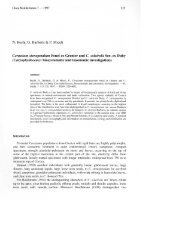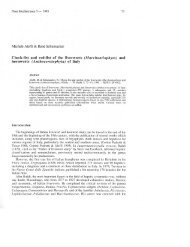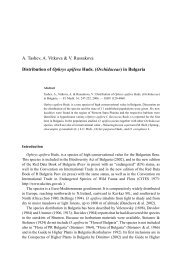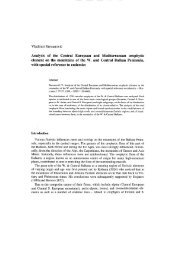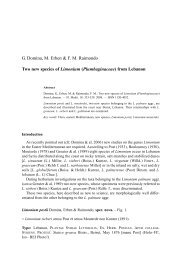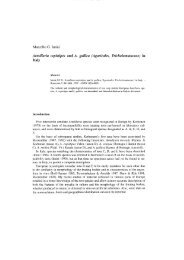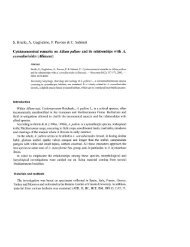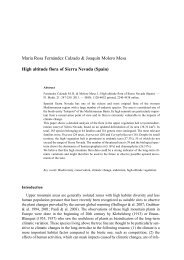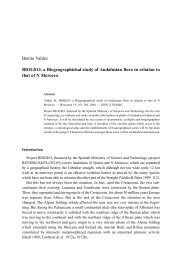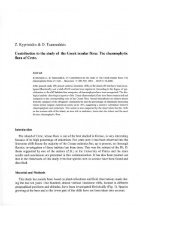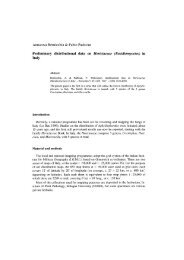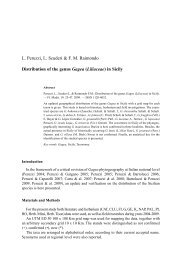Christoph Oberprieler The Systematics of Anthemis L. - Herbmedit.org
Christoph Oberprieler The Systematics of Anthemis L. - Herbmedit.org
Christoph Oberprieler The Systematics of Anthemis L. - Herbmedit.org
You also want an ePaper? Increase the reach of your titles
YUMPU automatically turns print PDFs into web optimized ePapers that Google loves.
20 <strong>Oberprieler</strong>: <strong>Anthemis</strong> in N Africa<br />
9. MorphologicaI features<br />
Duration and life form<br />
<strong>The</strong> majority <strong>of</strong> N African representatives <strong>of</strong> <strong>Anthemis</strong> are annuals belonging to A. sect.<br />
<strong>Anthemis</strong>, sect. Maruta, and sect. Cota. <strong>The</strong> annual habit may be interpreted as an adaptation<br />
to the dry semi-desert and steppe habitats <strong>of</strong> the adjacent areas <strong>of</strong> the Sahara, and to<br />
disturbed habitats or arable fields. A. stipa rum, A. confusa, or A. glareosa are prostrate<br />
annuals with reduced main axes and procumbent stems with smallleaves, found in natural<br />
stony and sandy habitats <strong>of</strong> the deserts. <strong>The</strong> vigorous growth <strong>of</strong> A. gharbensis and<br />
A. cotula, found as weeds in arable fields and along field margins in more hurnid areas,<br />
forms the opposite extreme habit <strong>of</strong> therophytic <strong>Anthemis</strong> in N Africa.<br />
<strong>Anthemis</strong> sect. Hiorthia contains short- to long-lived perenni al herbs which are restricted<br />
in N Africa to the hurnid areas <strong>of</strong> the coasts (A. maritima) or to the mountains <strong>of</strong><br />
the Atlas ranges <strong>of</strong> Morocco, Algeria, and Tunisia (A. abylaea, A. pedunculata,<br />
A. punctata, A. eretica subsp. columnae). At least A. pedunculata is capable to flower and<br />
set fruit already in the first year, and especially diploid plants are <strong>of</strong>ten found growing as<br />
weeds in arable fields, so that the differences between annual and perenniallife form seem<br />
not to be too c1ear-cut in this species. However, in better growing conditions<br />
A. pedunculata is c1early a short-lived perennial, with annual shoots arising from a woody<br />
stock (pleiocorm) formed by the bases <strong>of</strong> the primary and subsequent annual shoots.<br />
Tetraploid plants <strong>of</strong> A. pedunculata, along with representatives <strong>of</strong> A. abylaea, A. punctata,<br />
and A. eretica subsp. columnae, also grow as pleiocormous hemicryptophytes. Observations<br />
in the field and herbarium suggest that most representatives <strong>of</strong> these species have<br />
life spans <strong>of</strong> three to five years.<br />
Roots and rhizomes<br />
<strong>The</strong> root system type is c10sely correlated with habit and duration. In ali annuals <strong>of</strong><br />
<strong>Anthemis</strong> sect. <strong>Anthemis</strong>, sect. Maruta, and sect. Cota, taproots are found. <strong>The</strong> perennials<br />
in A. sect. Hiorthia are characterized by a woody caudex formed by the lignified bases <strong>of</strong><br />
previous years' shoots fused with the basai taproot. In younger individuals the caudex may<br />
be unbranched and only partly subterranean, in older ones branched and completely subterranean<br />
caudices (pleiocorms) may be found. In the perennial species, especially in<br />
A. maritima, accessory roots bome at the basai stem nodes are frequently observed which<br />
are missing in annuals, even if procumbent.<br />
Growth habit, stems and capitulescence<br />
<strong>The</strong> most simple condition in the <strong>org</strong>anisation <strong>of</strong> stem and disposition <strong>of</strong> capitula found<br />
in <strong>Anthemis</strong> is shown in Fig. lA: the mai n axis is erect and ends in a cymose capitulescence<br />
characterised by a terminai capitulum which flowers first. This type <strong>of</strong> capitulescence<br />
<strong>org</strong>anisation is found in most N African annuals, e.g. A. austriaca, A. ubensis, or<br />
A. monilicostata. Unsuitable growing conditions like drought or malnutrition may considerably<br />
reduce the number <strong>of</strong> developing branches and lead to poor capitulescences <strong>of</strong> few<br />
or a single capitulum.<br />
A more complicated condition <strong>of</strong> stem and capitulescence <strong>org</strong>anisation results when side<br />
axes are added beneath the main capitulescence (Fig. lB). Troll (1964) and Panero (1992)<br />
use the term parac1adia to designate these accessory flowering branches, each <strong>of</strong> which



